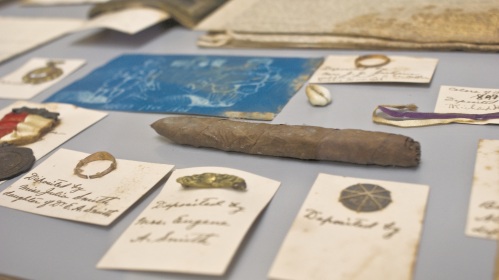A small but anxious crowd gathered on the second floor of Smith Hall around a small metal box, a time capsule that hadn’t been opened since May 28, 1907, buried underneath the cornerstone of the building.
The ceremony was a part of the 100th anniversary of Smith Hall, named in honor of Eugene Allen Smith, a UA professor who also served as state geologist.
Randy Mecredey, director of the Alabama Museum of Natural History, opened the ceremony by saying how exciting it is to be a part of something as nostalgic as the opening of a century-old time capsule.
“To think that we’re fortunate enough to have this opportunity is pretty remarkable,” Mecredey said.
Marguerite Smith-Turner, granddaughter of Smith, said that through the museum, she was able to get a better sense of her grandfather was.
“This is a magnificent building,” Smith-Turner said. “This is just a wonderful opportunity for us [the Smith family].”
Robert Clouse, executive director of UA Museums, also offered a few words of anticipation, saying how important the time capsule is in terms of understanding the University through both the past and the present.
“This should serve as a very exciting message from the past that will tell us what people then hoped for the future,” Clouse said. “We hope we find something as exciting as you all hope it is.”
Due to the box being soldered shut, it was necessary to cut the box open, Clouse said, so that they did not accidentally catch any papers inside the box on fire.
As the crowd peered in closer to get a better look at the contents of the box, they were bewildered as the first item was pulled out—a cigar.
Other items included a ring donated by Smith’s daughter, Julia, a UA Bulletin, a corsage worn by B.B. Comer, governor of Alabama from 1907-1911, during the burial of the time capsule, photographs of both Smith and then-alumni society president Hill Ferguson, as well as an unopened scroll, titled “To the President of the University (Some Centuries Hence).”
Jean Luc Robin, a professor in the French department, attended the event with his two children, Dorian and Penelope.
“I expected mostly papers, but I was still very excited about it,” Robin said.
Robin’s son, Dorian, said the most peculiar item he saw was a small, blue cartoon detailing the University’s defeat over Auburn in football in 1906 and in baseball in 1907.
“Some things never change,” Robin’s son said.
Robin said that although certain things in the box probably didn’t seem important at the time, what makes them relevant now is how they can be interpreted.
“It’s a great way to relate to former generations.”
Clark Center, curator of the UA Special Collections Library, said opening the capsule is not only a symbol of learning about the past, but specifically, what people living in the past wanted to ultimately say about themselves.
“What it represents is the people involved and what they wanted to be remembered for,” Center said.
In addition, Center commended Smith for all his contributions to the University, as well as to the state.
“Dr. Smith was also one of the first people to say that Moundville was important,” Center said.
Following the ceremony, Smith-Turner commented that although most things found in the box were less than stellar at first glance, it was still a remarkable experience to be a part of.
“It was sort of what we expected,” Smith-Turner said. “But there is still a fair share of excitement of this.”
Smith-Turner also said she is proud that she was part of an event over a century in the making.
“This box has taken us back over 100 years to see what was going on then,” Smith-Turner said. “In a lot of ways, much of what was going on then is the same as today.”







